A Gourmet’s Guide to Lismore - 4
The Gollan Milk Bar (85 Woodlark)
George Sargent is now the longest running Greek proprietor in Woodlark, having taken up residence in 1936, but a relative youngster in the long run of Woodlark machinations. His shop is believed to have been the site of an earlier fruit shop, perhaps Greek, handed onto the Gollan Hotel developers in ~1934. The Gollan gobbled up a number of old businesses in its reconstruction, including Denny Panaretto’s around the corner in Keen. But while Denny elected to forgo his right to a new shop in the enlarged Gollan building, George took up the old fruiterer’s entitlement and remained ensconced for the next 24yrs.
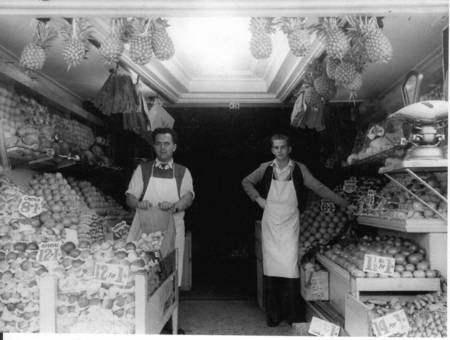
[Gollan Fruit Mart 1948. George Andrew Sargent (Stratigakis) left and unknown employee]
At this time there was a Greek vacuum in the Woodlark fruit business, Jack Feros at 73 Woodlark having moved to Byron Bay and Basil and Alex Feros at 61 Woodlark relocating to Magellan. George continued to have the trade to himself until post war when he, like most of the Greek fruiterers, started to feel the pinch from the Italians, in his case the main competitor being Mario Gasparini across the road. Mario’s became the main gathering place for the Italians, increasingly being seen on the streets from about 1950 as it became safer to leave the plantations. (And out the back were The Dreaded Card Games, the Italians being just as addicted as the Greeks. He folded about 6mths after Sargent’s Markets.)
Feeling Mario’s competition, George converted the rear of his shop into a milkbar around 1950, but started to lose heart in the whole increasingly competitive business after the destruction of the ’54 flood, which descended with a vengeance a week after the euphoria of the ’54 Royal Visit. The Gollan, still the most modern hotel in Lismore after the Civic, was deemed fitting accommodation for the Monarch and her Greek consort, crowds gathering the day before the visit and giving George the best trading he’d ever experienced. By the time the Queen appeared on the balcony for the royal wave 5000 of her loyal subjects had gathered in the street, including the large Greek contingent in national dress.
George battled on until 1960 before moving to Brisbane, in the meantime continuing to feel the squeeze from the range of new milk bars opening along the street. He was the last Greek café proprietor in Woodlark where his compatriots had dominated the trade from pre WW1.
Harry presses on, but pausing to check whether the Italian Fiore family has introduced any new innovations to the Uneeda Milk Bar at Number 73, the site of the first Andrulakis Oyster Saloon in 1903. The story goes that sometime during WW2, when the place was in the hands of Mrs Lillian Barrett, an out of town customer said ‘You need a milk bar’, prompting her to give the place a makeover to re-emerge as The Uneeda, allegedly the first dedicated milk bar in town. Mrs Pepper, a legendary Lismore dance band impresario, was the proprietor when Donato and Matilda Fiore took over in 1952. They introduced a pie that rivalled the Mecca, the recipe concocted by Donato after many years experience as a baker. They sold up in 1957, passing the pie formula to ‘Uncle Toms’ on the highway near Mullumbimby, where it quickly became famous up and down the whole North Coast. Shortly afterwards the Uneeda morphed into The Coffee Pot, and by the time it was absorbed into the next-door electrical retailing business in 2000, it could arguably claim to be the site of the second oldest continuous catering outlet in Lismore.
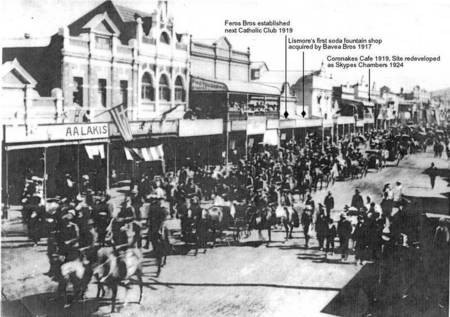
[Lismore Lancers parade down Woodlark Street 1914. Greek flag possibly being flown by Melbourne born Foiti (aka Con) Stratti Andrulakis. Stratti died 1908 and his wife Athena leased the business to Theo Dimitri Bange (Vangis) who moved to Bangalow in 1912 leaving Foiti as the gaffer. Foiti lasted a couple of years after which the place went out of Greek hands.]
Harry slows his stride at Number 55, the original shop taken up by Jack Jim Feros and his brother Peter upon coming from Dorrigo in 1919. It was passed to Basil and Alex John Feros, earlier of Mullumbimby, in 1929 when Jack acquired the Bavea Bros business next door at number 53. In 1934 Basil and Alex took up an ex-Italian fruit shop at 43 Magellan, but their old place came back into Greek hands in 1939 when it was absorbed into the Carkagis business. (Basil and Alex returned to Sydney in 1937 after their employee and nephew, Johnny Nick Feros, went off to buy Evans Head.)
Further progress down the street is hampered as Harry tries to negotiate the huge queue extending out of the Dairy Delite at 53 Woodlark. He has size on his side however, and quickly battles to the front, only to become transfixed by a recently installed stainless steel wonder. This magnificent thing, being operated by the harassed proprietor, Mr Clare, produces a continuous stream of soft ice-cream at the twist of a lever, and the schoolkids can’t get enough of the stuff, most rejoining the queue while still licking their first ration allotment. The Delite is on the site of the original Bavea Bros shop, and as at 2005, still under the Dairy Delite name, is the oldest café trading in Lismore. It was home to the town’s first soda fountain/milk bar in 1898 and went through a few hands until taken up by Peter Nick Bavea in 1917, sold to Jack Jim Feros in 1929 and passed to the old hands around the region, the Carkagis Bros, in 1935 upon Jack’s temporary move to Byron Bay. The Carkagis ended the Greek presence when they pulled out after the devastation of the ’45 flood.
After this reflective pause Harry advances to the Skypes Building at 29-33 Woodlark, constructed in 1924 with Emmanuel Harry Andronicos as the first tenant. He had taken over the original Catsoulis ‘Fresh Food Supply Company’ and relocated from the river side of Molesworth - and for the collectors of café obscuria, could wear the distinction as the first Kytherian proprietor in Singapore, where he spent 6yrs prior to arriving in Brisbane in 1923. (An earlier Singaporean was the seaman Dimitri Frilingos, who was based in the great trading port for 2.5yrs prior to jumping ship in Adelaide in 1911.) Manuel moved to Kyogle in 1927 and passed the business to Emmanuel Vlandis who subsequently relocated directly opposite. And this is where Harry does a right turn and a jay walk to view the only other Greek business left on Woodlark.
The Richmond Fish Shop (46 Woodlark)
Vlandis, trading as Landis & Co, was the first Greek tenant on this side of Woodlark, but in 1930 sold the business to Peter Emmanuel Stathis and went off to Brisbane to open one of the largest cafes in the CBD. He became a leading light in the Greek community, taking over from John Stratigakis (Sargent) as President of the Orthodox Community of Brisbane in late 1931. He was a foundation member of the Kytherian Association of QLD in 1934, along with Minas Tsikleas and Anthony Sourris whose sons young Harry has already encountered.
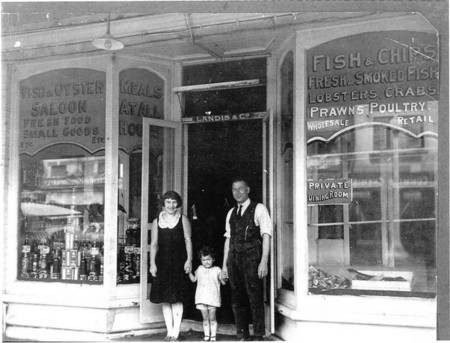
[Landis Oyster Saloon 1930. L to R: Dulcie Smith, Marika Vlandis, Emmanuel Vlandis]
Peter Stathis, with his brother-in-law, Minas (Mick) Mark Cassimatis, traded through to 1939 when they handed over to Nick Crethar and moved to Murwillumbah, where Mick’s son Mark opened the only other air-conditioned café on the north coast in 1940. (Mick, another seasoned international traveller, having spent 10yrs in Smyrna and 6yrs in the USA, and believed to have been in Murwillumbah pre WW1, died in Lismore in 1951.)
Nick, who lived upstairs with his family, won some bonus trade during the war when he was awarded the contract to feed the AWOL serviceman being held in the clink behind the shop. There was a constant flow of these blokes, representing all nationalities, who decided not to return to barracks after their leave passes expired. They were rounded up by the local police and held in the lock-up until the unamused MPs could get to town.
Nick traded through to 1945 when he sold out to Stratis (Stan) Karampasis of Mytilini and joined his brother Harry at the Regent. Stan, previously a banana grower of Rosebank, was initially in partnership with his brother John of Ballina until the Italian Ralph Sonego took up John’s shares around 1950. They served the cheapest fish ‘n’ chips in town, a fact sussed out very quickly by the army of schoolkids with limited pocket money. The pace was particularly frenzied following the Saturday afternoon matinee when the delinquents would roll up in droves shouting out their orders and impatiently watch Stan sweat away at the deep fryer while Ralph was going like the clappers peeling more potatoes.
The place was relatively spacious, but by the time they sold up in 1956 the basic tables and chairs were mostly occupied by those waiting for their takeaway order to be completed and wrapped in yesterday’s newspaper. Thereafter an Anglo-Australian proprietor, the entertaining Johnny Bird, carried on the tradition until the place, renamed Johnny's Fish Shop, closed in the early 60s. Today it’s even more spacious with a couple of walls knocked down to house North Coast Stationery, a business being run by Chris Macris, son of George earlier of the Blue Bird.
Having completed the circuit Harry hastens back to work before Angelo docks his pay, but on the way acknowledges more sites with ghosts of cafes past. Number 25 was Paul Coronakes’s 2nd home, basing himself here in 1924 after being kicked out of his original shop by the ‘Skypes Chambers’ developers. His new neighbours at number 23 are no longer Greek, but the shop had an illustrious past, housing the mysterious Mearas/Merras/Meras Bros from 1912, Athena Andrulakis in 1916, the Comino Bros (Mina & Nick Anthony of the ‘Oyster Kings’ family) in 1917, Nick Poulos in 1918 and the feisty Mrs Effie Gundlach in 1920. She took command of the ‘alien’ forces from Peter Feros and Peter Bavea during the Great Barrow Wars of 1923, but, alas, also retired from the fray later in the year to open a general store in South Lismore. The place was back under Greek management from the mid 30s to the mid 40s when Peter Grivas, a probable Ithacan, manned the counter.
Bertha’s cake shop at 17 Woodlark was previously the home of Nick Poulos’s first shop, subsequently passing through the hands of Theo Francis, George Poulos, George Patrinos, Angelo Crethar and finally Angelo’s brother Menus, who passed it out of Greek hands in 1930 upon return to Kythera. The folklore goes that Menus was a touch miffed when Angelo opened up his nth sundae shop next door in 1929, installing Nick Crones as his partner/manager. Nick ended the Greek presence in 1936, but the shop, number 15, continued in the catering business, nowadays as Zen Sushi.
A couple of doors down a cosmetic shop at number 11 now occupies the site of the very first oyster saloon on the North Coast, opened by Peter Emmanuel Comino (Giraldis) in early 1903 and transforming the diet of the Lismoriotes. And as at 2005 that very same shop is the prized possession of Peter Coronakes. The three-storey building, constructed in 1915. 4yrs after Comino relocated to Molesworth, is still the most futuristic looking building in Lismore, and now looking very swish after Peter gave it a facelift. (And his new clothes on the Tudor have set the benchmark for other property owners in revitalizing the CBD after many years of neglect.)
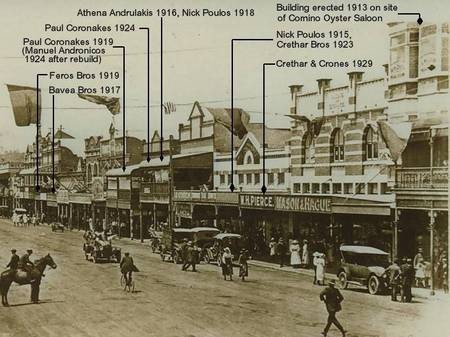
[Woodlark Street 1920]
At the intersection of Woodlark and Molesworth Harry again doffs his hat to a Lismore institution, ‘The Café de Wheels,’ which started business at the same time as Comino and remained a landmark until washed away in 1974, having gone though many transformations over the years; from horse and cart to caravan. There would have been blood on the streets if the council had been silly enough to include it in the agonising over hawker’s licenses during the Great Barrow Wars of 1923, at which time it was providing Lismore’s gourmets with 45doz pies a day. And it could so easily have been Greek if Theo Patras, who introduced a ‘Mr Whippy’ service around mid 1904, hadn’t lost his hawker’s license after giving a bit of lip to an officer who arrested him for obstructing Woodlark traffic. Said the officer at the hearing in 1906: “…the shandrydan … is a flag-decorated ‘juggernaut’, the approach of which is invariably heralded by headache-creating blasts from a discordant trumpet.” The Terakes marketing team would’ve loved him.
Over the bridge in North and South Lismore the Greek presence has faded, with Denny Panaretos being the only shop proprietor left in South and Jack Nick Bavea with his catering business the only Greek in North. Jack gave the game away in about 1956, while Denny hung on until the early 1970s before retiring to Perth.
The End
The Greeks at this time had reached their peak presence in Lismore, making up a mere 0.3% of the city’s population but controlling about two thirds of the catering outlets, and certainly all the posh places. How did they subsequently slip from such a dominant position when they previously had proved so adaptable to changing economic and social circumstances? Apart from the fact that their Australian born children were capable of patricide if a catering career was suggested, and the absence of fresh Greek blood to replace the current crop of proprietors reaching retirement, (the post war migrants mostly preferring the smog of Sydney or the industrial belt from Newcastle to Wollongong), there was a range of factors, not least of which was the sheer speed of the still accelerating commercial, social and technical revolution. What might have been, if, if, if …:
Post war prosperity was given a huge kick-start when tens of thousands of pounds were paid out in deferred pay and war gratuities to ex-servicemen, enabling upward mobility. A building boom got underway and new subdivisions began to appear on the outskirts of town, progressively draining the pubs, flats and boarding houses in and around the CBD of a traditional customer base for the cafes. The concomitant growth in car ownership enabled families easy access to alternate social and entertainment outlets away from the town center, particularly over weekends when the CBD lost out in favour of the beach.
In 1954 came the end of the ‘six o’clock swill’, with trading hours extended to 10PM and a restart in the evolution of Australian pub culture. The lounge bars rather than the cafes became the preferred evening meeting places for the after-theatre crowd and the after-dinner promenaders around the block, an old Lismore mating ritual for the lads and lassies displaying their peacock plumage. [This popular barn dance, with the blokes walking clockwise around the block meeting the gals rotating anticlockwise, started in the 1920s.]
In 1956 came the dreaded poker machines, pouring riches into the clubs and enabling the introduction of subsidized meals that the cafes couldn’t match. The clubs rapidly expanded, offering new entertainment acts, pop bands, all sorts of facilities, and becoming bigger booze retailers than the pubs, turning the way-of-life of the community again on its head. Their ‘one stop shop’ dining-out experience left no crumbs for the cafes. The Italians, never in the catering game to any great extent, built the Italo-Australian Club in North Lismore in 1963, added the giant auditorium in 1966 and dominated the dance and entertainment scene for many years, providing more meals than all the cafes put together, although the game certainly was over by then.
The pubs counter-attacked with more substantial counter-lunches, a step up from the traditional snacks placed on the bar and a couple of saveloys on a plate, but taking sometime to evolve into the popular bistros. While they had no effect on the clubs, the cafes, many of which were sited near the pubs, suffered collateral damage. (And the pubs couldn’t take a trick; the ballooning motel business continuing the haemorrhaging.)
[Not all the woes of civilization can be laid at the feet of the clubs however. While they certainly aided and abetted the death of great dance venues like the Riveria, the Apollo and the Federalette, they at least kept jazz, swing and the big band sound on life support in the face of rock band opposition, at least for a short while. Inevitably the incomparable music of Glen Miller, Benny Goodman, et al, (and classics such as ‘Moonlight Serenade’, ‘In the Mood’, ‘American Patrol’, …) was drowned out by electric guitars.]
The year 1956 also marked the introduction of free-to-air TV and the rapid decrease in patronage of the theatres which, coupled with the eventual death of the dance halls, added more distress to the evening traders as crowds further declined around the block. Lismore’s very own Channel 8 arrived in 1962, but, alas, lost it and staff to Coffs Harbour in the early 1970s.
In 1963 a second river crossing was completed, effectively giving Lismore a bypass and taking traffic away from the old route through Woodlark Street. The change in traffic flow led to an expansion of the CBD towards the alternate route through Ballina Street, Woolies being the first major retailer on the scene with a new shopping complex south along Carrington.
The 1960s saw a rapid change in the nature of shopping as the manpower intensive department stores gave way to the new chainstores, changing the pattern of dining for customers and staff alike, followed by another whammy in the early 1970s when Woolies and Coles halved their staffs upon going fully self-service. In 1979 Lismore Square, the giant stand-alone shopping mall outside the CBD that consumed around 50 residential houses in its construction, sucked the life out of the block. The place became one of the largest employers in Lismore, with about 1000 full-time and casual staff dining away from the CBD, and just recently doubled in size, consuming another 25 houses plus parkland and a public road donated by a generous council. In between came political machinations that saw the closure or relocation of a host of Government departments, the final straw that had the multiplier effect leaving vacant shops everywhere around the block and hardly a pedestrian on the streets, once so packed and vibrant. While business has since picked up the geographical centre of Lismore continues to shift towards the coast as the council, also deserters of the CBD, approves more subdivisions in Goonellabah and beyond and refuses expansion over the river in North and South.
On the farms, still the economic backbone of the region in the 1950s and 60s, things were looking very shaky. The banana industry suffered a death by a thousand cuts and gluts and by the mid 60s was knock, knock, knockin’ on Heaven’s door. The dairy industry was shedding farmers at the rate of about one a week and by the mid 1960s had the lowest land values and lowest income of any dairy region in Australia. The farmers, effectively on the dole, could barely give their places away, for which the hippie settlers on the dole were very grateful, but the region retained the distinction as the place of highest concentration of dairy farms in the nation. Over the period 1952-72 the region’s herd more than halved and by 1973 a rural recession saw the remaining farmers struggling to the same degree as in the Great Depression. The multiplier effect of less work opportunities in rural and subsidiary industries was felt down the line, further eroding the customer base of the cafes along with all the other retailers. By the time of the final industry deregulation in 2001, the great Norco, once boasted as the largest dairy cooperative in the world, was close to collapse. Along the way the traditional market days transformed and the customary all day shopping trip by the farming families with lunch, and maybe dinner, in town changed to an ad hoc basis.
As well as shedding cows the region was shedding people, exporting a potential unemployment problem as the youth gravitated to the bright lights of the metropolis. From the late 50s, and for the first time ever, the Richmond region’s population went into decline, although Lismore’s surrounding farming shires had never recovered to pre war peaks. Towns and villages like Nimbin, Bonalbo, Woodenbong, et al, became basket cases, further undermining the demand for Lismore’s manufacturing services and distribution businesses. And by the early 60s Lismore itself began stagnating, remaining so for the next 15yrs before starting a slow recovery. Even so, while still viewed as the regional capital, its rate of growth continues to be comprehensively trounced by that along the coast, to where the population drift seems irreversible.
By 1959 things must have been desperate for Lismore to elect its first ever Labour MLA. The times were a-changin’ rapidly. Even the women were getting uppity, receiving equal pay in 1958 (theoretically anyway), but we won’t go there - mini skirts, the pill, Ms Greer, and on and on, that saw the patriarchal Greeks popping valium. More pertinent to the cafes was the emergence of fast food chains; from Colonel Sander’s Chooks to Big Macs and all the copycats in between.
And of great concern to Harry Crethar at the Wonder Bar were the comments of Judge Stephens in late 1959: “…about 20% of milk bars were ‘picking up places’ for law breaking hoodlums.” Bodgies, widgies, milkshakes, tutti fruttis, jukeboxes and pinball machines were a potent combination and a breeding ground for delinquents, ‘eh Harry.
The Greek Community
By the late 1930s there were enough children in the district, both Greek and Australian born, to warrant the employment of a Greek schoolteacher to keep alive Greek language and cultural values in the second generation (to the alarm of the assimilationists.) The leading light in galvanising the communities in the region was Matina Crones who started agitating for a Brisbane priest to do a regular circuit through the area from about 1940. Subsequently it seems the priest gave way to Angela Demas, a school teacher of South Lismore. And folklore has it that Patra Coroneo, another qualified school teacher and the sister-in-law of Denny Panaretto, had the job for a couple of years in the mid 1940s before returning to Perth.
Then came Mrs Ecaterina Savvas in the early 50s. She and her husband, Socrates, were from long-established Greek families in Romania who became refugees into Greece after the Communist takeover. How they happened to find themselves in Lismore is a mystery, but both were well-educated and sophisticated, bringing an element of old-world Greek culture to town. Socrates could speak six languages and held degrees from the University of Constantinople and the German University of Leipzig. He fought in both world wars and was allegedly a General in the Romanian Army in the second. He was a foundation member of the revamped ‘Greek Community of Lismore’ and association secretary for 13yrs, accepting his change in status with good grace as he did menial jobs in the cafes and banana plantations.
Mrs Savvas, accepting a wage from a levy on those of the communities of Lismore, Mullumbimby and Murwillumbah, was very busy travelling by train around the region. She taught during the week in Lismore, giving Greek lessons after school on Tuesdays and Thursdays, then on Fridays travelled to Byron Bay, drilling the Feros children, before moving on to Mullum on Saturday morning and Murbah on Sunday. She died in Lismore in 1979, Socrates having predeceased her in 1966.
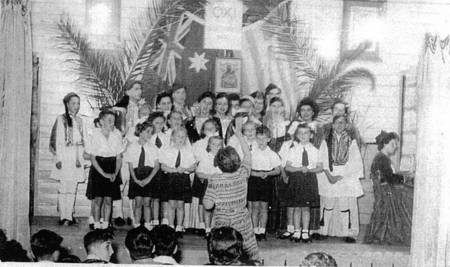
[Greek Liberation Day, Bexhill, 25Mar1955. Mrs Mary Black on piano and Mrs Ecaterini Savas conducting.]
However, religious instruction remained cursory until 1963 when Fr Theodoros Kousiandos was finally appointed as a combined resident priest and teacher following a decade long campaign by the Lismore Orthodox Community. Nonetheless, Mrs Savas was one who wasn’t happy, as her only source of income had been her paid teaching position. Unfortunately the community couldn’t afford two wages, as well as housing and other financial support for the priest and his family, so she went into retirement and apparently lived on some sort of pension thereafter.
Fr Kousiandos’s parish was a large one and involved a lot of travel between all the major towns on the North Coast, conducting services, weddings, baptisms and burials as well as religious instruction. He was relieved in 1965 by a retired Cypriot monk, Fr Kallistratos Adamou, who agreed to live with Vim Gialouris to cut costs. He wasn’t replaced upon leaving in 1968, as by this time the North Coast community was into rapid decline.
An Orthodox Community allegedly was established in Lismore around 1930 and the subsequent growth rate of the district’s Greek community up to about 1950 was so great that Lismore was long mooted as the centre for a possible North Coast Parish. Until 1924 the priests of Sydney probably included Lismore in their yearly circuit to Brisbane and selected towns in NSW and QLD. Brisbane didn’t acquire its first resident priest until 1922 when Fr Daniel Maravelis arrived from Melbourne, after which regular visits from Brisbane to conduct services in St Andrews Cathedral (Church of England) were the norm. Up to the 1940s the Rev Nicon Patrinacos was in regular attendance from Brisbane until replaced by the charming Chrys Boyazoglu.
The mass influx of Greek banana growers to Murwillumbah and Mullumbimby, predominately Ithacan, but with a fair swag of Cypriots, Rhodians and others (although the Macedonians – WE ARE NOT GREEK – outnumbered them all), combined with the cane cutters allotted to the Tweed by the Commonwealth Employment Service, switched the focus of a likely parish to Murbah at one stage. There too however, numbers rapidly declined following collapse of the banana industry.
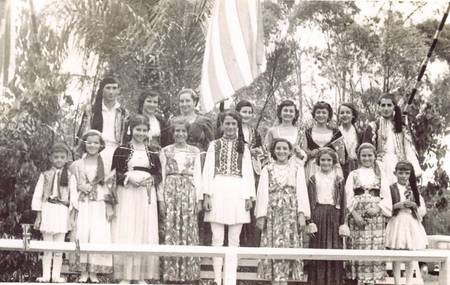
[Greek Monarchists, 1954 Royal Visit Lismore
Back row L to R: George Peter Feros, Tasia Jim Poulos (Tzortzopoulos of Ballina), Maria Sourry (nee Terakes), Maria Karambasis, Martha Manias (nee Cassis), Zeta Cassis, Anna Caponas (Mullumbimby), Peter Dendrinos.
Front Row L to R: Gerry Cassis, Penny Alidenes (Mullumbimby), Sophia Bavea, Phyllis Crones, Stan Karambasis, Loula Bavea, Mary Crones, Chrissie Cassis, Angelo Crones.]
In the heyday of the Richmond, Tweed and Brunswick communities, particularly after wives and children arrived, social life was hectic. Picnics were held at the beach, bus trips were organised to scenic spots and functions were held at various halls in the region, mainly Burringbar and Bexhill where matchmaking was a feature of the mixing. But it all started to fade away in the late 1950s when the combined communities peaked at around 600 Orthodox adherents (representing less than half the regional total of persons of Greek heritage mind you). The interaction declined, though Murbah remained an active community into the late 60s while Lismore continued until 1970 under the presidency of Charlie Anthony Sourry. Today the Hamburger King and protagonist of this story, Harry Eric Crethar, sporting the worst haircut in the world, shepherds the remaining Northern Rivers flock.
After 50yrs domination of the catering trade, giving the Greeks a high profile around town, their legacy is zilch, zero, nothing. They were chameleons, attempting to blend through membership of Rotary, the Masonic Lodge, most community organisations and the Country Party, and making little effort to introduce anything other than the traditional Australian fare from the cafes, let alone influencing the direction of the community’s social and cultural development. In the face of the great assimilation pressure there was no cross-pollination and their descendants are now as mainstream Australian as the next ocker. (But ‘assimilation’ wasn’t just an imposition on ‘aliens’ - until the baby boomer insurrection everybody had to conform to the norms of the time or risk a clip across the ears. Thereafter ears were camouflaged behind long hair and barbers became another guild consigned to history.)
Post war the Lismoriots had a significant exposure to Southern Europeans, particularly Italian, giving a heightened awareness of other values and ways-of-life, which proved not so different on closer inspection. The day-to-day contact in the cafes, shops and streets, the interaction at P & C meetings, the clashes on the sports’ fields, the visibility of the large groups in national dress at parades, festivals and carnivals, the high profile Continental Balls, and the newspaper prominence given to the ‘New Australians’ in general, caused the initial fear of the invasion, (manifested in ‘dago’ name calling, the odd bit of biffo and knockbacks at dances), to fade with familiarity - around the same time any embryo multiculturalism was dying along with the café trade and the banana plantations.
The long evolution of Lismore’s corporate culture was, and continues to be, shaped through a range of complex local and external forces, with no pressure from any curious historical accident of a fleeting Greek presence, although their mere presence as ‘aliens’ helped mould some of the social attitudes and political forces still evident. Ditto the Italians, in far greater numbers over a longer period, whose poorly patronised club and deserted bocce rinks are all that is left.
While the Greeks and all the other national groups in the post war influx participated in the forging of a new Australia, around the Richmond-Tweed the various varieties of high profile home-grown ‘Alternative Lifestylers’ (The Hallucinogenic Hippies, The Gough Groupies, The Colonic Irrigationists, The Tree Huggers, et al) were the driving force, giving the region an illusory reputation as a cultural smorgasbord. The place still has less than half the State average of foreign born citizens (11% v. 23%), yet it’s asserted that ‘The Rainbow Region’, the latest name thrust on the Richmond-Tweed by the marketers, is now one of the most culturally diverse in NSW, giving a new spin to the definition of ‘multiculturalism' ('cultimutualism'?). While there are certainly various small tribes, permeated by different values, now making up the once monocultural local society, the way-of-life of the vast bulk of the citizens retains an Anglo cultural focus, including that of the melded Greeks.
And on that track record, current concerns on harmless multiculturalism, as originally defined, and the subtle coupling with the alleged deterioration of something called ‘Australian core values’, are misdirected.
[Psst: Lismore now has a 'Cafe and Culture Trail' to raise the city’s profile as a 'cultural and culinary destination', with footpath markers denoting the spots of 'significant cultural interest'. And guess where one of those plaques rests? And it didn't cost him a cent.
He, refusing the sobriquet of ‘Old Harry’, still walks the block, resisting the temptation to offer gratuitous advice as he notes the comings and goings of new cafes and coffee shops, the endurance of some and the swift death of others, the changing food fads and management styles. He observes however, that on a pro rata basis, (ie applying fiddle factors in the comparison of apples and oranges, or mixed grills verses stuffed spatchcock with a fancy French name), Lismore has never produced another café in the class of the Capitol or Crethar’s, or developed another cuisine that can be identified as distinctly Lismorian. Will he make a comeback? Stay tuned while he digests some stats:
Over the 12mths to Jun04 the nation’s 15,000 restaurants and cafes (however defined) generated $10 billion in revenue, made up 0.5% of GDP, employed 190,000 people (50% casual), but only made 4% profit. (Conversely, the average profit of the 28,900 restaurateurs and caterers represented by Con Castrisos’s Restaurant and Catering Association of Australia was 2%, the bulk of the owner/operator’s income generated by paying him/herself a wage of $14/hr.) Aren’t you glad you chose the customer’s side of the counter.]